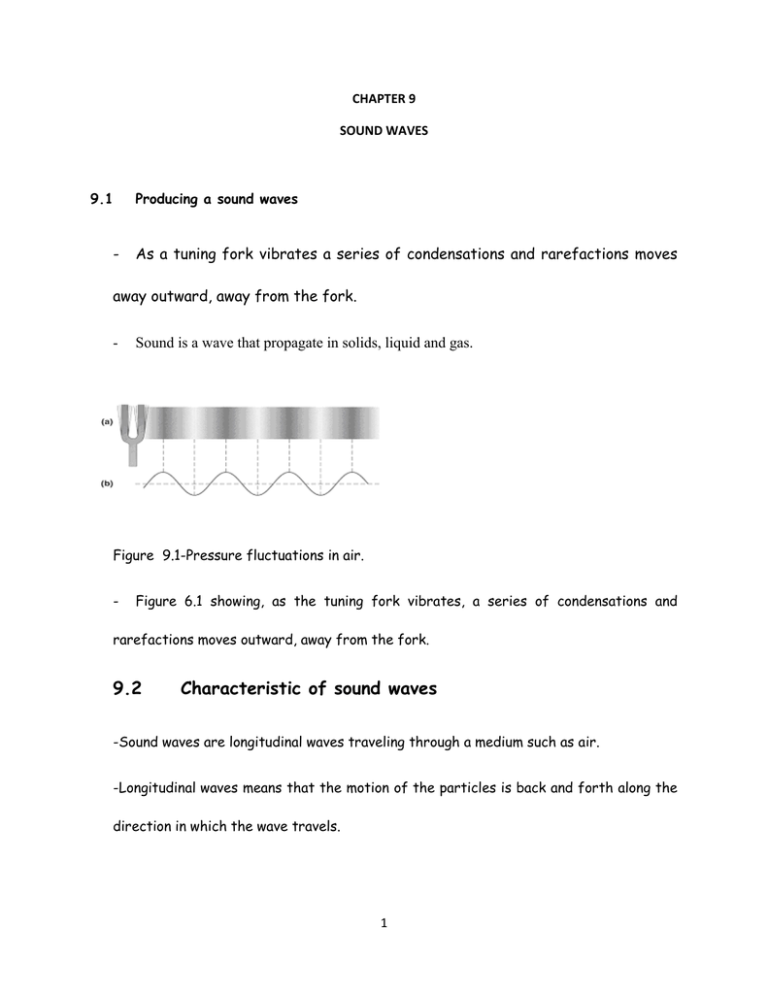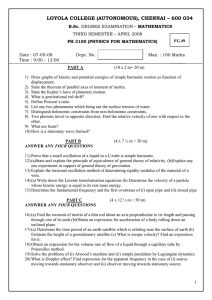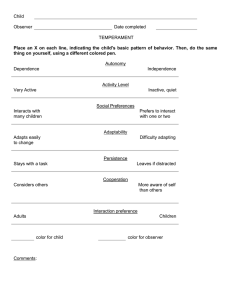9.2 Characteristic of sound waves
advertisement

CHAPTER 9 SOUND WAVES 9.1 - Producing a sound waves As a tuning fork vibrates a series of condensations and rarefactions moves away outward, away from the fork. - Sound is a wave that propagate in solids, liquid and gas. Figure 9.1-Pressure fluctuations in air. - Figure 6.1 showing, as the tuning fork vibrates, a series of condensations and rarefactions moves outward, away from the fork. 9.2 Characteristic of sound waves -Sound waves are longitudinal waves traveling through a medium such as air. -Longitudinal waves means that the motion of the particles is back and forth along the direction in which the wave travels. 1 -Sound waves, while traveling through the air, making an alternating series of regions of molecular density and air pressure. 2 - Regions of high density and air pressure are called compression or condensation. Regions of lower than normal density are called rarefaction. - Sound frequency spectrum consists of three regions, f < 20Hz infrasonic region 20 Hz < f < 20 kHz audible region 20 kHz < f ultrasonic region 9.3 The speed of sound - - The speed of sound in a medium depends on : 1. elasticity 2. mass/density 3. temperature of the medium The speed of sound in solid v = where ρ Y = Young’s modulus = density of the medium. - The speed of sound in fluid v = B ρ 3 where B = Bulk modulus = density of the medium. - The speed also depends on the temperature of the medium. And it is written as: v = (331 m/s ) 1 T 273 where 331 m/s is the speed of sound in air at 00C and T is the temperature in degrees Celsius. Example 9.1 A sound wave has a frequency of 700Hz in air and a wavelength of 0.50m. What is the temperature of the air? Solution: The speed of the sound wave is v = f = (0.500 m) x (700 Hz) = 350 m/s. Therefore, v = 350 m/s = (331 m/s) 1+ T 273 from which T = 32.2°C Example 9.2 The density of a certain metal solid is 7.2 103 kg/m3 and its Young’s modulus is 10 1010 N/m2. What is the velocity of sound in this metal? 4 Answer: 3700 m/s Example 9.3 The range of human hearing extends from approximately 20 Hz to 20 000 Hz. Find the wavelengths of these extremes at a temperature of 270C. Solution: The speed of sound at 27 °C is: Thus, the wavelengths are: - v 1+ 27 m = 347 . 273 s 347 m/s 20 Hz = f = 20.0 Hz = 17.3 m, v 20,000 Hz = f = And 9.4 v = (331 m/s) 347 m/s = 1.7 x 10-2 m. 2.0 x 104 Hz The Doppler Effect In general, a Doppler effect is experienced whenever there is relative motion between a source of waves and an observer. When the source and observer are moving toward each other, the observer hears a frequency higher than the frequency of the source in the absence of relative motion. When the source and observer are moving away from each other, the observer hears a frequency lower than the source frequency. 5 - - This effect is study base on three main cases: A. Observer moving (towards or away) while the source stationary. B. Source moving (towards or away) while the observer stationary. C. Source (towards or away) and observer (towards or away) in motion. First case: A. Observer moving while the source stationary. Hence the frequency will be heard when the observer moving toward the source: f0 = f s v v0 v The frequency heard by the observer traveling away from the source: fo = f s v v0 v these two equation can be incorporate into one: fo = f s v v0 v The positive sign is used when the observer is moving toward the source, and the negative sign is used when the observer is moving away from the source. 6 - Second case: B. Source moving while the observer stationary. The frequency heard by observer A as the source moving toward the observer: fo = f s ( v ) v vs When the source moving away, the stationary observer will hears a decreased frequency of: fo = f s ( - v ) v vs So for the source moving (towards and away) while the observer stationary, the equation can be written as: v fo = fs v vs - Third case: C. Source and observer in motion. If both source and the observer are in motion, one finds the following general relationship for the observed frequency: 7 v v0 v vs fo = fs the upper signs refer to motion of one toward the other, and the lower signs refer to motion of one away from the other. Examples 9.7 (Observer moving while the source stationary) A train at rest emits a sound at a frequency of 1000Hz. An Observer in a car travels away from the sound source at a speed of 30 m/s. What is the frequency heard by the observer? (Taking v = 345 m/s as the sound of air). Solutions: Using, fo = f s v v0 v fo = (1000 Hz) 345 m/s - 30.0 m/s = 913 Hz. 345 m/s 8 Examples 9.8 (Source moving while the observer stationary) An airplane traveling with half the speed of sound (v=172 m/s) emits a sound of frequency 5.00 kHz. At what frequency does a stationary listener hear the sound as the plane approaches? Solutions: If the source is approaching at half the speed of sound (vs = - We have : fo=fs ( v 2 ), v ) = 2f = 10.0 kHz. v - v/2 Examples 9.9 (Source and observer in motion) Two trains on separate tracks move toward one another. Train 1 has a speed of 130km/h and train 2 has a speed 90.0 km/h. Train 2 blows its horn, emitting a frequency of 500 Hz. What is the frequency heard by the engineer on train 1? Solution: Both observer and source are moving, so we use fo = f( v ± vo v ± vs )with Vs = 90.0 km/h = 25.0 m/s ( source moves toward observer) and V0 = 130 km/h = 36.1 m/s ( observer moves toward source) 345 m/s + 36.1 m/s Thus, f o= (500 Hz) 345 m/s - 25.0 m/s = 595 Hz. 9 9.5 Interference of sound waves - Since sound is a wave, it has all the wave characteristics – can be reflected, refracted and diffracted. - Sound wave interfere when they meet. - Constructive interference - when two waves meet in a region where they are in phase. - - Destructive interference – when two waves meet in a region where they are not in phase. Interference can be constructive or destructive depending on the path-length difference ( L ) of the waves. L n , n=0,1,2,… constructive interference L m / 2 , m=1,3,5 destructive interference 9.6 - Standing waves A combination of incident and reflected waves according to superposition principle – standing waves. Interfering waves of the same frequency, wavelength and amplitude in opposite directions in a rope can produce a standing wave. It was called standing waves because it appears as it is not moving. Node – amplitude is zero Antinode – the wave vibrating at the highest amplitude. 10 Figure (a) : no vibration Figure (b) : L 1 1 2 First harmonic Figure (c) : L 2 2 2 Second harmonic Figure (d) : L 3 3 2 Third harmonic L n n 2 where n = 1,2,3,… General equation : or - In general, fn n 2L n n FT n n nf1 n 2L 2L 2L 11 where n = 1,2,3,4………. f2 = - The next highest frequency, f3 = - 2v v = = 2 f1 2L L 3v = 3 f1 2L The frequency of = f1 , 2f1, 3 f1 ………… form a harmonic series where f1 the lowest frequency of the vibrating string and is called as fundamental frequency / first harmonic. Example 9.10 Find the first four harmonic of a 1.0m long string if the string has a mass perunit length of 2.0 10-3 kg/m and is under a tension of 80N. Solution: The speed of the wave on the string is v= F = 200 m/s then, f1 = 1 2L F = 100 Hz. The frequencies of the next three modes are f2 = 2f1 12 f3 =3f1 f4 = 4f1 that is, f2 = 200Hz f3 = 300Hz 9.7 f4 = 400Hz. Forced vibrations and resonance. - Forced vibration – This is a phenomenon where a system is forced to vibrate by giving it a driving force. - Resonance – A phenomenon where a system of spring vibrate at a maximum amplitude because the frequency of the driving force equal to the system natural frequency, f0 ( or called the resonant frequency) 9.8 Standing waves in air columns. - Musical instrument provide good examples of standing waves. - Stringed musical instrument produce notes by setting up transverse standing waves in strings with different fundamental frequencies. : eg: guitar / violin - Standing waves are also set up in wind instrument. For example, consider a pipe organ with fixed pipe lengths, which may be open (Open at both ends) or closed (Closed at one end and open at the other end). 13 1. - Open Tube – a pipe open at both ends; Natural frequency for a pipe open at both ends: fn n 2. v 2L n = 1,2,3…… Closed Tube – a pipe closed at one end and open at the other end Natural frequency for a pipe open at one ends and closed the other : fm m v 4L m = 1,3,5…… 14 Example 9.11 A pipe has a length of 2.46m a) Determine the frequencies of the first three harmonics if the pipe is open at each end. Take 345 m/s as the speed of sound in air. b) What are the lowest possible frequencies if the pipe is closed at one end and open at the other? Solutions a) n = 1, using f1 = 345m/s v = = 70 Hz. 2L 2(2.46m) So, f2 = 2f1 = 140Hz ; f3 = 3f1 = 210 Hz. Using the same method, b) n =1, f1 = 345m/s v = = 35Hz, odd harmonics, f3 = 105 Hz ; f5 = 175Hz 4 L 4(2.46m) Example 9.12 A 3.00 m long pipe is in a room where the temperature is 200C. Case 1 : Open pipe a) What is the fundamental frequency? b) What is the frequency of the second harmonic? Case 2 : Closed pipe a) What is the fundamental frequency? b) What is the frequency of the second harmonic? Solution: The speed of sound at 20 °C is: .a) For an open pipe f n n v=(331 m/s ) v nf1 n= 1,2,3…… 2L 15 1 m T =343 . s 273 343m / s 57.2 Hz and 2L 2(3) f 2 2 f1 2(57.2) 114Hz f1 1 b) For a closed pipe f m m f1 1 9.9 - 4L v 4L m = 1,3,5…… 343m / s 28.6 Hz 4(3) Even harmonic cannot exist in a closed pipe. There is no second harmonic. Beats. Another interesting interference effect occurs when two tones of the nearly same frequency ( f1 f2 ) are sounded simultaneously. - The ear sense pulsations in loudness known as beats. - The beat frequency is equal to the difference between the two frequencies. 16 Beat frequency ( fb) given by, fb = f1 - f2 Example 9.24 How many beats will be heard in 5 second, when two forks with frequencies of 516 Hz and 513 Hz are sounded simultaneously. Solutions fb = f1 - f2 = 516 Hz - 513 Hz = 3 Hz ( 3 beats in each second) so, 3 5 = 15 beats will be heard. 17

